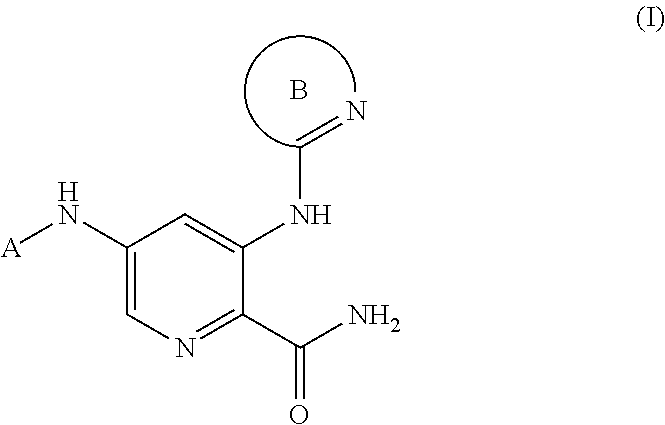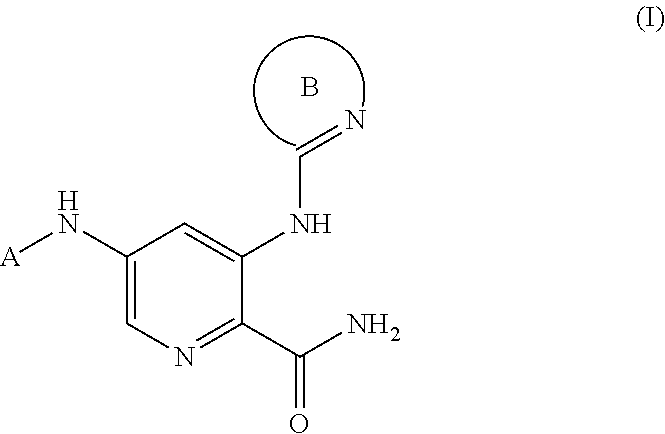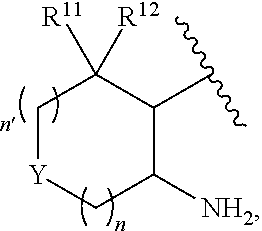2-Pyridyl Carboxamide-Containing Spleen Tyrosine Kinase (SYK) Inhibitors
a technology of spleen tyrosine kinase and carboxamide, which is applied in the direction of biocide, drug composition, immunological disorders, etc., can solve the problem of reducing the production of rheumatoid factor
- Summary
- Abstract
- Description
- Claims
- Application Information
AI Technical Summary
Benefits of technology
Problems solved by technology
Method used
Image
Examples
example 1
Conversions from Scheme 1—Conversion of A1 to Structural Subtype A
[0636]The preparations in this example describe the procedure for conversion of A1 to compounds of structural subtype A.
example 1.1
Preparation of 5-{[(1R,2S)-2-aminocyclohexyl]amino}-3-[(4,6-dimethylpyridin-2-yl)amino]pyridine-2-carboxamide
[0637]
[0638]Step 1: To a flask were added 3-bromo-5-fluoropyridine-2-carbonitrile (14.8 g, 73.5 mmol), tert-butyl [(1S,2R)-2-aminocyclohexyl]carbamate (15 g, 70 mmol) and DIPEA (49 mL, 280 mmol). The resulting mixture was heated at 110° C. After 14 hours, the reaction mixture was cooled to room temperature, diluted with dichloromethane, absorbed on silica gel, and purified via silica gel chromatography to afford tert-butyl {(1S,2R)-2-[(5-bromo-6-cyanopyridin-3-yl)amino]cyclohexyl}carbamate. 1H NMR (600 MHz, DMSO-d6) δ 8.06 (s, 1H), 7.22 (s, 1H), 6.86 (d, J=7.8 Hz, 1H), 6.68 (d, J=7.8 Hz, 1H), 3.78 (s, 1H), 3.62 (s, 1H), 1.64-1.44 (m, 6H), 1.30 (s, 9), 1.14-1.08 (m, 2H).
[0639]Step 2: To a flask were added tert-butyl {(1S,2R)-2-[(5-bromo-6-cyanopyridin-3-yl)amino]cyclohexyl}carbamate (21.5 g, 54.4 mmol), 2-amino-4,6-dimethylpyridine (9.97 g, 81.7 mmol), Pd2(dba)3 (2.49 g, 2.72 ...
example 1.2
5-{[(1R,2S)-2-aminocyclohexyl]amino}-3-{[6-(2H-1,2,3-triazol-2-yl)pyridin-2-yl]amino}pyridine-2-carboxamide
[0643]
[0644]Dioxane (1.06 mL), 6-(2H-1,2,3-triazol-2-yl)pyridin-2-amine (51 mg, 0.32 mmol) and cesium carbonate (311 mg, 0.955 mmol) were added to tert-butyl {(1S,2R)-2-[(5-bromo-6-cyanopyridin-3-yl)amino]cyclohexyl}carbamate (PrepEx 1.1) (94 mg, 0.32 mmol) in a scintillation vial. The vial was purged and flushed with argon three times before Pd2 dba3 (29 mg, 0.032 mmol) and Xantphos (28 mg, 0.048 mmol) were added. The vial was purged and flushed 3 times with argon before the vial was sealed and heated to 80° C. After 16 hours, the reaction mixture was cooled to room temperature, filtered through CELITE (washed with dichloromethane), and diluted with water. The organic layer was dried over sodium sulfate, filtered, and concentrated under reduced pressure. The residue was purified by silica gel chromatography (10-70% acetone in hexanes, linear gradient) to afford tert-butyl {(1S...
PUM
| Property | Measurement | Unit |
|---|---|---|
| Composition | aaaaa | aaaaa |
| Therapeutic | aaaaa | aaaaa |
Abstract
Description
Claims
Application Information
 Login to View More
Login to View More - R&D
- Intellectual Property
- Life Sciences
- Materials
- Tech Scout
- Unparalleled Data Quality
- Higher Quality Content
- 60% Fewer Hallucinations
Browse by: Latest US Patents, China's latest patents, Technical Efficacy Thesaurus, Application Domain, Technology Topic, Popular Technical Reports.
© 2025 PatSnap. All rights reserved.Legal|Privacy policy|Modern Slavery Act Transparency Statement|Sitemap|About US| Contact US: help@patsnap.com



